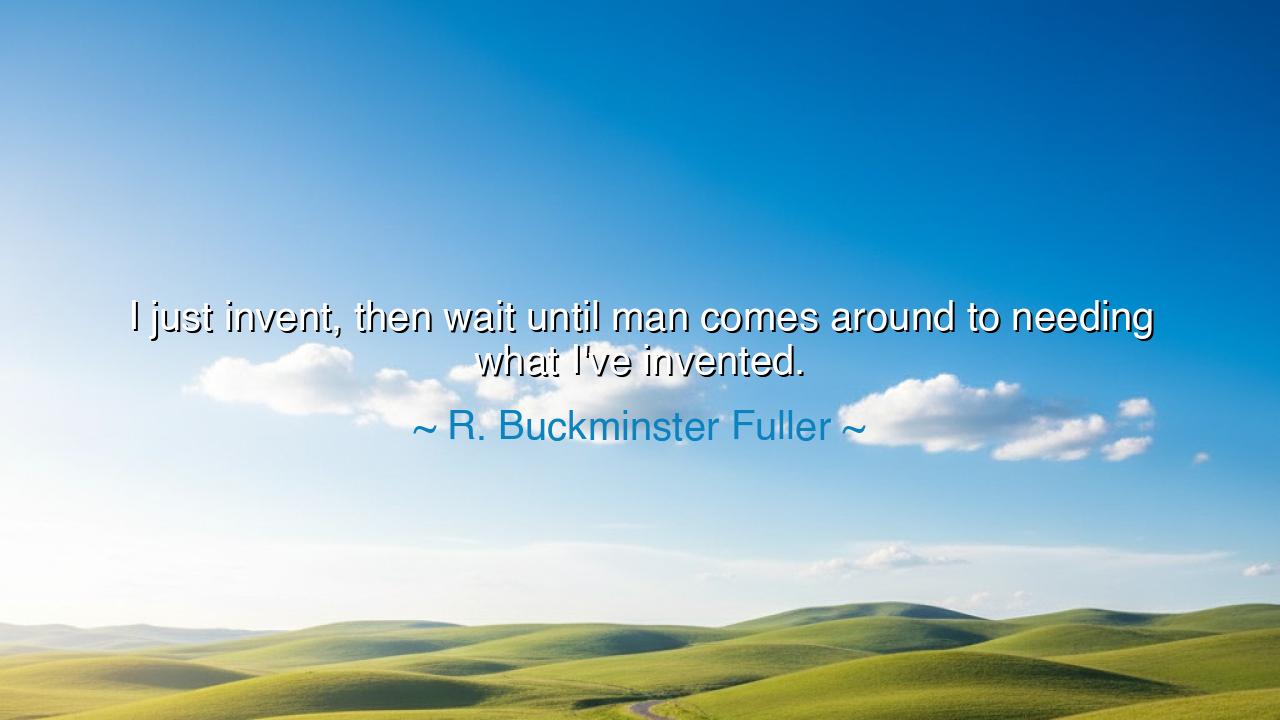
I just invent, then wait until man comes around to needing what






When R. Buckminster Fuller declared, “I just invent, then wait until man comes around to needing what I’ve invented,” he spoke as one who sees beyond the horizon of time. His words carry the weight of patience and the fire of vision. Fuller was no mere maker of objects; he was a seer, a prophet of possibilities. In his spirit burned the truth that the world often lags behind the dreamers who shape its future. What he crafted was not always understood in his own day, for invention often precedes understanding, and the gift of vision is sometimes a lonely crown.
To invent, as Fuller did, is to stand in the place of the ancients who dreamed of ships before sails, of wings before flight, of light before fire was tamed. The inventor does not merely answer present needs; he dares to address the needs that humanity has not yet awakened to. Thus Fuller embraced the sacred burden: he created, knowing that the world might not yet be ready, but trusting that time itself would vindicate his vision. Such is the fate of those who serve the future rather than the present.
Think of the story of Leonardo da Vinci, who sketched flying machines centuries before the Wright brothers lifted into the skies. The world was not ready for his designs; the materials, the engines, the understanding were yet unborn. But da Vinci planted seeds, and in time, others harvested the fruits. Fuller, like da Vinci, lived in the realm of possibility, where invention comes first, and acceptance follows when mankind at last recognizes its hunger.
The meaning of Fuller’s words is both heroic and humbling. It teaches us that the inventor must be both bold in creation and patient in waiting. The world may scorn, may ignore, may fail to grasp what has been offered. Yet the true creator does not falter, for he serves not the applause of the present but the destiny of the future. His task is not to chase approval but to build the bridge before others realize they must cross the river.
And so Fuller’s inventions—his geodesic domes, his visions of sustainable living, his dreams of “Spaceship Earth”—were not always embraced in his own time. Many saw them as eccentric, impractical, or unnecessary. Yet now, in an age haunted by environmental peril and thirsting for sustainable solutions, his words and works rise again with new power. What was once dismissed as strange is now recognized as prophetic. The world, at last, has begun to come around to needing what Fuller long ago conceived.
The lesson is clear, O seekers of wisdom: be not afraid to create what the world does not yet ask for. If your vision is true, time will be your ally. The future will one day call upon the seeds you have planted, even if the present casts them aside. The greatest gifts of humanity have always seemed strange at first—electric light, vaccines, flight, the Internet. Yet each became indispensable once the moment of recognition arrived.
Therefore, live not merely for the demands of today, but for the possibilities of tomorrow. If you are an inventor, an artist, a thinker—create boldly, and then wait with patience. Trust that when the season is right, your work will bear fruit. Nurture your creations not with haste, but with faith, knowing that humanity often learns slowly what its soul has long been longing for.
Thus, Fuller’s words are a call to courage and endurance: “I just invent, then wait until man comes around to needing what I’ve invented.” Create with the daring of visionaries, endure with the patience of sages, and one day, when humanity awakens to its deeper needs, it will find that you have already prepared the path. This is the way of the true builder of worlds.






AAdministratorAdministrator
Welcome, honored guests. Please leave a comment, we will respond soon